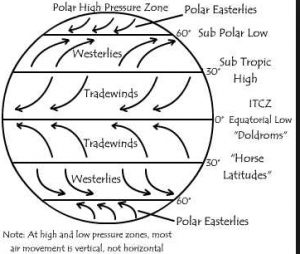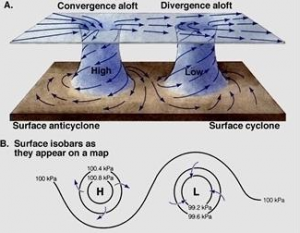Essential Questions:
- What are the similarities and differences between the 3 major wind systems?
- What are the four types of fronts?
- How do high and low pressure systems differ?
Vocabulary:
- Coriolis Effect
- Polar easterlies
- Prevailing westerlies
- trade winds
- jet stream
- front
Global Wind Systems page 318
There are 3 basic wind systems in each hemisphere
- polar easterlies
- prevailing westerlies
- trade winds
Jet Streams page 321
Jet stream is a narrow band of fast moving wind with speeds of up to 400 km/hour at altitudes of 10.7 – 12.2 km.
Fronts page 322
Air masses with different characteristics cab collide and result in dramatic weather changes. The narrow region between two air masses of different densities is called a front.
http://www.phschool.com/atschool/phsciexp/active_art/weather_fronts/
Complete the table
| Symbol | Sketch | Type of weather | |
| Cold | |||
| Warm | |||
| Occluded | |||
| Stationary |
Pressure Systems page 323
Air always flows from high to low pressure.
High pressure air is sinking air while low pressure air is rising air. If image is unclear, use this link
http://www.wfmz.com/image/view/-/183898/highRes/1/-/3jqcfb/-/pressure-2-jpg.jpg
| High pressure | Low pressure | |
| Cyclone or anti-cyclone | ||
| Air rises or falls | ||
| Direction of turn | ||
| Type of weather |
The image shows the direction of turn in the northern hemisphere. Would the direction of the turns be the same in the southern hemisphere? Explain.
Check Yourself. Can you answer all essential questions?
Computer Lab:
Site 1: Air Masses: The Basics
http://itg1.meteor.wisc.edu/wxwise/AckermanKnox/chap9/airmass_rev.html
Site 2: Air Masses in the USA
http://www.srh.weather.gov/srh/jetstream/synoptic/airmass.htm
Site 3: Air Masses: More information
http://usatoday30.usatoday.com/weather/tg/wamsorce/wamsorce.htm
Site 4: Air Masses: Visualizations
Site 5: Cold Fronts
http://ww2010.atmos.uiuc.edu/%28Gh%29/guides/mtr/af/frnts/cfrnt/def.rxml
Site 6: Warm Fronts
http://ww2010.atmos.uiuc.edu/%28Gh%29/guides/mtr/af/frnts/wfrnt/def.rxml
Site 7: Warm Front
http://ww2010.atmos.uiuc.edu/%28Gh%29/guides/mtr/af/frnts/wfrnt/def.rxml
Site 8: Stationary Front
http://usatoday30.usatoday.com/weather/tg/wsfront/wsfront.htm
Site 9: Occluded Fronts
http://www.atmos.illinois.edu/earths_atmosphere/airmasses_fronts.html
Site 10: Locating Air Masses
http://itg1.meteor.wisc.edu/wxwise/AckermanKnox/chap9/airmass_Front.html


